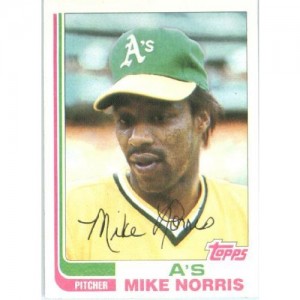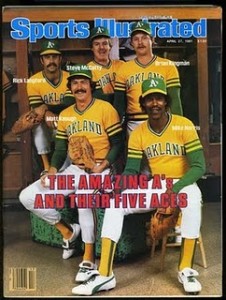1980 AL Cy Young Race Revisited
March 19, 2011 by David Nathan · Leave a Comment
 Mike Norris celebrates his 56th birthday on March 19. He was the runner-up for the 1980 Cy Young Award in which he and Baltimore starter Steve Stone compiled career years, but did he deserve to win the award?
Mike Norris celebrates his 56th birthday on March 19. He was the runner-up for the 1980 Cy Young Award in which he and Baltimore starter Steve Stone compiled career years, but did he deserve to win the award?
Player Background
Mike Norris was a 1st round pick by Oakland in the 1973 draft and made his debut in 1975.  He had five different managers in five seasons with the mercurial and parsimonious Charlie Finley owning the team, and Norris registered a 13-25 record heading into his age 25 season.
Steve Stone was a 4th round pick by the Giants in 1969 and made it to the big leagues to start the 1971 season. After two losing seasons, he was traded to the White Sox with Ken Harrelson for pitcher Tom Bradley. He went 6-11 in 1972, prompting a multi-player trade to the Cubs for fan favorite Ron Santo. Stone notched back-to-back winning seasons, including a strong ’75 when he went 12-8 (with a WAR of 3.5). He was granted free agency after an injury-marred 1976 season and signed with the White Sox again, where he became a front-line starter with over 200 IP the next two seasons. A free agent once again, Stone signed with the Orioles in 1979 and went 11-7 in his first season with a team than won 103 games and lost to the Pirates in the World Series (he only pitched two middle relief innings in a Game 4 win, surrendering 2 runs). Entering his age 32 season, Stone was 78-79 for his career.
Team Background
The Oakland A’s pulled of a World Series three-peat from 1972 to 1974. They were swept in the 1975 ALCS by the Red Sox, finished second to the Royals in 1976, and then traded or let all their best players leave via free agency. The result was three horrific seasons in which they lost 98, 93 and 108 games.
Here’s what became of the 1975 WS Champions: Gene Tenace (C)–granted free agency after ’76 season. Joe Rudi (1B)–sold to Boston in ’76. Phil Garner (2B)–traded after ’76. Bert Campaneris (SS)–granted free agency after ’76. Sal Bando (3B)–granted free agency after ’76. Claudell Washington (OF)–traded after ’76. Billy North (OF)–traded in ’78. Reggie Jackson (OF) traded after ’75 with Ken Holtzman (SP) to Baltimore. Vida Blue (SP)–sold to the Yankees in ’76 but the sale is voided days later by Bowie Kuhn; eventually traded after ’77. Rollie Fingers (CL) granted free agency after ’76.  Finley even traded his 1976 manager, Chuck Tanner, to Pittsburgh for catcher Manny Sanguillen.
After hitting rock bottom in 1979, Finley hired hot-tempered manager Billy Martin . The situation prompted Tonight Show host Johnny Carson to observe, “Charlie Finley hiring Billy Martin is like Captain Hook hiring the alligator.” Martin had already worn out his welcome in Minnesota, Texas and New York–fired by George Steinbrenner in both 1978 and 1979. Martin ushered in the short-lived era of Billy Ball (1980-1982), which umpire Nestor Chylak explained, “is a system of play where you fight your own players, the others’ players, the umpire, owners, press, and strangers in a bar, and then, when you win, and someone wants to know the secret, you say ‘Teamwork.'”
Meanwhile, from 1969 to 1979, the Baltimore Orioles won the AL East six times and had an AL three-peat of their own from 1969 to 1971, reaching the WS all three years, winning in 1970. In 1979, they held a 3-1 Series lead before the We Are Family Pirates came back to win.
The 1980 Season
Under Billyball, Martin rarely used the bullpen, allowing all five starters to throw deep into games. Norris (22-9) along with Rick Langford (19-12), Matt Keough (16-13), Steve McCatty (14-14) and Brian Kingman (8-20) each pitched over 200 innings, and the quintet started an amazing 159 of 162 games with an utterly absurd 93 complete games. The A’s went from 54 wins to 83, finishing in second place, 14 games behind the Royals.
Despite the remarkable season, Norris did not make the All-Star team. He did win the Gold Glove (Rdef 17) and finished with an impressive 5.8 Wins Above Replacement.  The basic stats of Norris’s outlier season are 22-9, 2.53 ERA, 33 games started (24 CG), and a league-low 6.8 hits per 9 innings.
Steve Stone’s Orioles won 100 games and still finished three games behind the Yankees. They had a quartet of pitchers log over 22o IP, including Scott McGregor (20-8), Jim Palmer (16-10)Â and Mike Flanagan (16-13). Stone decided to go for broke that season, reportedly throwing curveballs half the time, finishing 25-7 with nine complete games. Stone reflected, “I knew it would ruin my arm, but one year of 25-7 is worth five of 15-15.”
The Cy Young Vote
Stone received 100 points to Norris’s 91 to win the award–each received 13 first place votes. Yankees reliever Goose Gossage finished a distant third with 37 points.
Stone won the most games (25 to 22), but otherwise Norris has him beat in every meaningful category, new and old.
| IP | ERA | WHIP | K | CG | WAR | |
|---|---|---|---|---|---|---|
|
Norris
|
284.1 | 2.53 | 1.048 | 180 | 24 | 5.8 |
|
Stone
|
250.2 | 3.23 | 1.297 | 149 | 9 | 3.9 |
| * |
| * |
Stone gave up more hits, runs, earned runs, walks and home runs while throwing fewer innings.
In the MVP voting, Stone finished ninth (53 points) and Norris finished 15th (10 points). And that guy who finished third in the Cy Young voting? Goose Gossage finished third in the MVP voting as well–behind George Brett and Reggie Jackson. And Royals closer Dan Quisenberry, who finished fifth in the Cy Young vote, got more MVP consideration than Stone, landing in 8th with 70 points.
So What Gives?
Was it a black and white thing? While playing the race card might be easy, black pitchers had won the award in the 70’s (Vida Blue, Fergie Jenkins, Bob Gibson), so it can’t be just that.
Was is a legacy thing? The Orioles won the most Cy Youngs in the Seventies: Jim Palmer won it three times (1973, 1974, 1976) and Mike Flanagan won in 1979. Perhaps voters were accustomed to voting for Baltimore pitchers.
Was it an age thing? Stone was 32 while Norris was 25. Stone had the longer history of solid pitching while Norris had never had a winning season. Perhaps there was a bit more of a lifetime achievement in the voting.
Was it an East Coast Bias? The Orioles were contenders from Opening Day, while the A’s were the Cinderella story. Certainly the A’s were not featured often on the Game of the Week. Meanwhile, Stone garnered more national attention throughout the year, and he started the All-Star Game (tossing three perfect innings), which was the biggest stage to display his talents during the regular season. And a pennant race with the Yankees only increased his exposure (he went 3-0 versus New York).
The answer seems to be a classic case of All of the Above. Just look at the 1980 Academy Awards and you’ll see that the greatest accomplishment with the longest-lasting appeal doesn’t always win. Martin Scorsese’s classic Raging Bull lost out to Robert Redford’s excellent (but not timeless) Ordinary People. Or reconsider the 1979 Grammy Award for Best New Artist in which Elvis Costello and the Cars were bested by the disco one-hit-wonder A Taste of Honey.
The Aftermath
In the strike-shortened 1981 season, Norris won another Gold Glove, made the All-Star team, and finished 12-9. The A’s made it to the postseason, winning the first half of the season. They defeated the Royals in the ALDS with Norris pitching a shutout in Game One. Finally the A’s were swept by the Yankees in the ALCS. In 1982, Norris fell to 7-11 and then his career ended in 1983 after a 4-5 record. He struggled in the minors for several seasons, hoping for a return, which he made briefly with Oakland in 1990, tossing 27 relief innings (3.00 ERA) before leaving the majors for good.
Stone was plagued by tendinitis in 1981, going 4-7 before he retired. In 1983, Stone joined WGN as the color commentator for Cubs games alongside the legendary Harry Caray. For 14 years, they became indelibly linked as one of the most famous broadcast booth duos. He currently calls games for the White Sox with Ken Harrelson.
Ask most baseball fans about the Billyball A’s, and they’ll recall that Martin overused a young staff and ruined their arms. Dusty Baker heard those same critics after Kerry Wood and Mark Prior suffered injuries after throwing lots of innings. Yet the pitching philosophy works both ways. While Martin and Baker are reviled for ruining pitchers, along comes Rangers President Nolan Ryan who extols the virtues of pitchers throwing deeper into games, and the result is their first-ever World Series birth. But that’s a discussion for another day.
And that’s how I spent a free morning on my Spring Break.



